[Work Log] Work Log
Finished training.
training_result =
final_const_variance: 1.1669e-04
final_branch_const_variance: 1.7636e+03
final_linear_variance: 1.4425e+03
final_geodesic_variance: 195.4912
final_geodesic_scale: 0.0065
final_noise: 0.0776
training_result.initial
ans =
const_variance: 831.7886
branch_const_variance: 0.8552
linear_variance: 0.1183
euclidean_variance: 1.7367
euclidean_scale: 1.0000
geodesic_variance: 225.8247
geodesic_scale: 1.0000
epipolar_variance: 1.7367
These just don't make sense. It allows for almost zero total translation, but lots of pert-curve translation (const_variance vs. branch_const_variance). Linear variance allows for way too much scaling. Geodesic variance seems sensible, but the (inverse-squared) geodesic scale is way too low... Basically this becomes a stand-in for const_variance. Perhaps this is just a local minimum, we could try fixing const_variance to some large number and forcing geodesic variance to serve its intended purpose.
But the strangest thing is that
I sampled some curves from this prior, and they are about what I'd expect: rotated and scaled with very little nonrigid deformation. Below is a sample, along with the mean tree barely visible in the center:
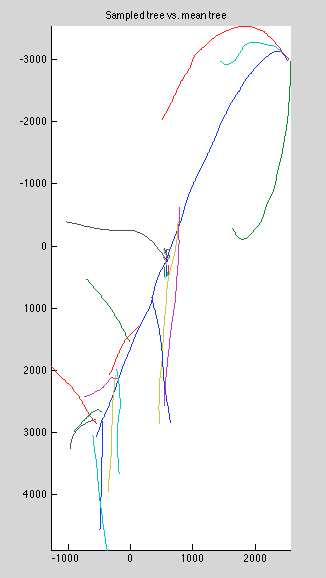
- Branches remain connected to tree, despite large per-curve offset variance.
- covariance matrix is singular
Ruled-out causes of error:
- badly implemented logmvnpdf. Tested against reference implementation.
Training observations
The simulated annealing algorithm is very sensitive to our local minima. It can sometimes find a good result in less than 500 iterations, but other times it gets stuck after less than 100 and never improves. I can probably tweak the annealing schedule to increase temperature earlier(is "reannealing" the right value to tweak?").
The patternsearch algorithm beats simulated annealing after only 16 iterations (vs. 5k or more). Annealing really struggles to get out of that minimum.
Surprisingly, after adding a seventh parameter (for branch-specific affine deformation), patternsearch totally fails to find a good minimum starting from default parameters. Initializing it with the result of the six-parameter model gives much better results. This suggests a coarse-to-fine strategy for training might work well in general. However, this is a very specific case: the six-parameter model was flexible enough to explain the data quite well, but was overly permissive -- it allowed too many nonsensical solutions. Adding the seventh parameter introduced an alternative explanation of the data, one requiring less nonrigid deformation.
To try: genetic algorithm; particle swarm; simplex method; start pattern search from SA result; globalsearch; grid search with multistart
Globalsearch & multistart w/ simplex fminunc
Misc results
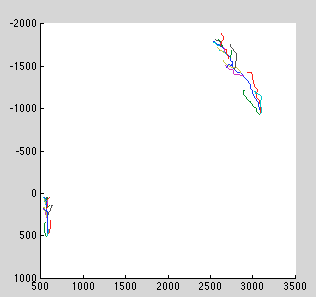
log-likleihood = -3.1787e+03
training_result =
final_const_variance: 6.0197e+06
final_branch_const_variance: 1.5774e-09
final_linear_variance: 1.6250
final_geodesic_variance: 238.6891
final_geodesic_scale: 0.0039
final_noise_variance: 0.1487
Not bad. Lots of geodesic variance to account for distortion. Why is const variance so high? Linear variance seems a bit high, but reasonable.
It might be a good idea to allow each branch to have a linear distortion relative to its initial point.
log-likelihood = -2.5318e+03
training_result =
final_const_variance: 2.3156e+09
final_branch_const_variance: 2.4988
final_linear_variance: 33.8221
final_geodesic_variance: 1.7165e+03
final_geodesic_scale: 0.0029
final_noise_variance: 0.0880
Much smaller noise variance, much higher for all other variances. const variance is astronomical... is the optimizer exploiting numerical error arising from a poorly-conditioned matrix?
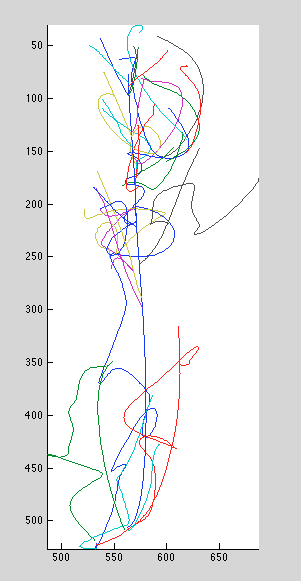
log-likelihood = -2.4848e+03
training_result =
final_const_variance: 0.1383
final_branch_const_variance: 1.7466
final_linear_variance: 5.4218e-04
final_geodesic_variance: 378.6715
final_geodesic_scale: 0.0048
final_noise_variance: 0.0832
This is close to what I would hope for -- small constant and linear variance, most variance coming from deformation. Still, the scale is fairly short (~14 pixels), allowing for quite a bit of deformation.
Ran for several thousand more iterations. Seem to be converging.
log-likelihood = -2.4799e+03
training_result =
const_variance: 0.0717
branch_const_variance: 3.2826
linear_variance: 0.0028
geodesic_variance: 401.4291
geodesic_scale: 0.0047
noise_variance: 0.0831
Running from scratch with the "pattern_search" algorithm, I got excellent results very quickly:
log-likelihood = -2.4256e+03
training_result =
const_variance: 261.7339
branch_const_variance: 3.0796
linear_variance: 0.0035
geodesic_variance: 165.2169
geodesic_scale: 0.0063
noise_variance: 0.0821
These are the most sensible results yet! Moderately large constant variance , small but nonnegligible branch constant variance. A touch of linear variance to rotations. Smaller deformation variance in response to larger const variance. Yes!
Adding a new parameter assigning independent affine deformation variance to each branch. This should allow less variance to be allotted to geodesic_variance, which should improve marginal-likelihood.
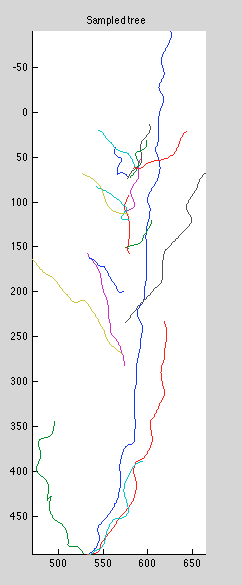
Initial training pass failed to find the old local minimum. Restarting it using the previous optimum resulted in very nice parameters:
log-likelihood = -2.3107e+03
training_result =
const_variance: 291.9853
branch_const_variance: 2.0196
linear_variance: 0.0366
branch_linear_variance: 0.0516
geodesic_variance: 12.7402
geodesic_scale: 0.0136
noise_variance: 0.0796
Note the dramatic drop in geodesic variance and increase in marginal likelihood. On the other hand, the (corrected) geodesic scale dropped from(~12 to ~8), meaning slightly higher effective dimension. The resulting tree looks much closer to the original shape than previous models.
Previous model had a problem: allowing each curve to affine-transform independently results in parents drifting away from children, which in reality isn't possible. We need each child to inherit the covariance of the parent, which we accomplish by simply taking the dot-product of the "geodesic" index.
The pattern_search algorithm is having a hard time finding a better set of
Starting from the same position as previous starting point, results in a worse log-likelihood:
log-likelihood = -2.3131e+03
training_result =
const_variance: 3.1017e-25
branch_const_variance: 2.9157
linear_variance: 0.0326
branch_linear_variance: 0.0575
geodesic_variance: 12.5426
geodesic_scale: 0.0137
noise_variance: 0.0796
Zero const variance is troubling. Other parameters are mostly unchanged, except slightly higher branch_const_variance. It seems the translation component was mostly used to align curves affected by parallax.
Actually, zero const variance isn't so surprising, because our now model alls branches to pivot around their starting point, and the root of the tree hardly moves between views. What movement there is could be solved by pivoting the whole tree around it's center, using the global affine transformation.
It seems we have a redundant representation here. The branch affine transformations subsume the global affine transformation, unless there's evidence that a multi-level type of model is reasonable (which it might be).
Starting from the result of the previous run gives slightly better results, but still not better than the "bad" model used previously.
log-likelihood = -2.3122e+03
training_result =
const_variance: 498.3842
branch_const_variance: 2.9623
linear_variance: 0.0400
branch_linear_variance: 0.0523
geodesic_variance: 12.0562
geodesic_scale: 0.0138
noise_variance: 0.0799
Now optimization approach, adding one dimension at a time and reoptimizing. Results are almost identical to second-to-last run:
log-likelihood: -2.3131e+03
training_result =
noise_variance: 0.0800
geodesic_variance: 12.3965
geodesic_scale: 0.0136
branch_linear_variance: 0.0576
branch_const_variance: 2.9157
linear_variance: 0.0327
const_variance: 8.3205e-09
Again, low const_variance, but we manually can do 1D optimization to improve it:
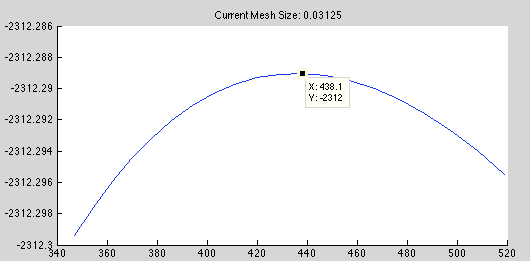
training_result =
noise_variance: 0.0800
geodesic_variance: 12.3965
geodesic_scale: 0.0136
branch_linear_variance: 0.0576
branch_const_variance: 2.9157
linear_variance: 0.0327
const_variance: 435.8995
Some plots showed that at low const_variance, the terrain become rocky, making search difficult.
Forcing noise variance to be 1.0 results in much smoother priors:
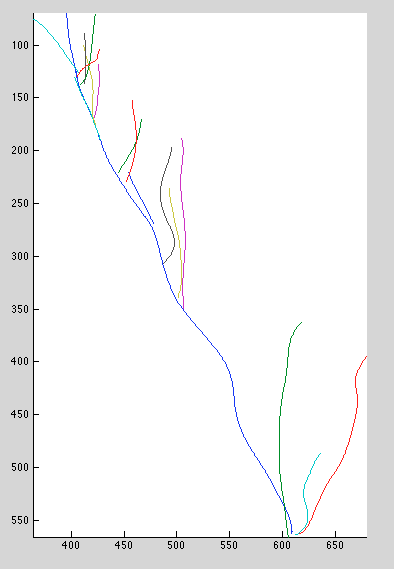
training_result =
noise_variance: 1
geodesic_variance: 15.9174
geodesic_scale: 0.0019
branch_linear_variance: 0.0485
branch_const_variance: 3.7438
linear_variance: 0.0348
const_variance: 685.7670
This kind of makes sense, since our point-correspondence algorithm has mean error of 0.5, even if correspondences are perfect. In many cases, correspondences aren't perfect, because the triangulation metric used to find correspondences isn't sufficiently informative to infer the true correspondence. So forcing i.i.d. noise variance to some minimum value prevents the prior from taking up that noise.
misc notes
Try different deformation model - cubic spline?
euclidean affine transform
next:
- train epipolar likelihood
- MCMC
- from sample to raster
- train bernoulli likelihood
- adaptive MH (or test with just simulated annealing)
Dangling tasks:
- train on multiple different view-pairs
- ground-truth and train on neighboring views (rather than four-separated)
